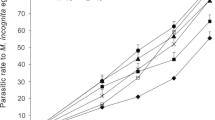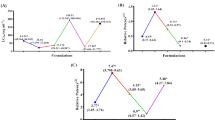Abstract
The southern root-knot nematode (Meloidogyne incognita) is one of the most devastating threats to cucumber production in China. The ban of methyl bromide and restricted use of other fumigants and high-toxicity of non-fumigant nematicides increases the need for more selective non-fumigant nematicides that pose fewer risks to the environment to manage M. incognita. Fluopimomide is a new fungicide with a similar chemical structure to fluopyram, a fungicide possessing nematicidal activity. However, the efficacy of fluopimomide against M. incognita and its effects on cucumber yield have not been evaluated. In this study, we examined the nematicidal effect of fluopimomide on M. incognita under laboratory and field conditions. In the laboratory, fluopimomide was highly toxic to second-stage juveniles (J2s) and eggs of M. incognita with a median lethal concentration (LC50) of 8.1 and 11.6 mg L−1, respectively, after 24 h exposure. In field trials, fluopimomide applied at 250, 500 and 750 g ha−1 was effective in reducing population densities of M. incognita J2s and root galling caused by the nematode, meanwhile, enhancing plant height in two consecutive years (2017–2018). Furthermore, fluopimomide at 750 g ha−1 significantly increased fruit yield of cucumber compared to abamectin and fosthiazate, the most widely used non-fumigant nematicides to manage M. incognita in China. Overall, soil application of fluopimomide was effective in management of M. incognita in cucumber production, while enhancing cucumber fruit yield.



Similar content being viewed by others
References
Abawi G, Widmer T (2000) Impact of soil health management practices on soilborne pathogens, nematodes and root diseases of vegetable crops. Appl Soil Ecol 15:37–47
Back M, Haydock P, Jenkinson P (2002) Disease complexes involving plant parasitic nematodes and soilborne pathogens. Plant Pathol 51:683–697
Barker KR, Townshend JL, Bird GW, Thomason IJ, Dickson DW (1986) Determining nematode population responses to control agents. In: Hickey KD (ed) Methods for evaluating pesticides for control of plant pathogens. APS Press, St. Paul, pp 283–296
Collange B, Navarrete M, Peyre G, Mateille T, Tchamitchian M (2011) Root-knot nematode (Meloidogyne) management in vegetable crop production: the challenge of an agronomic system analysis. Crop Prot 30:1251–1262
Dahlin P, Eder R, Consoli E, Krauss J, Kiewnick S (2019) Integrated control of Meloidogyne incognita in tomatoes using fluopyram and Purpureocillium lilacinum strain 251. Crop Prot 124:104874
Devran Z, Söğüt MA (2009) Distribution and identification of root-knot nematodes from Turkey. J Nematol 41:128
Duniway J (2002) Status of chemical alternatives to methyl bromide for pre-plant fumigation of soil. Phytopathology 92:1337–1343
Duval H, Van Ghelder C, Portier U, Confolent C, Meza P, Esmenjaud D (2019) New data completing the spectrum of the Ma, RMia, and RMja genes for resistance to root-knot nematodes (Meloidogyne spp.) in Prunus. Phytopathology 109:615–622
Expósito A, García S, Giné A, Escudero N, Sorribas FJ (2019) Cucumis metuliferus reduces Meloidogyne incognita virulence against the Mi1.2 resistance gene in a tomato-melon rotation sequence. Pest Manag Sci 75:1902–1910
Faske TR, Hurd K (2015) Sensitivity of Meloidogyne incognita and Rotylenchulus reniformis to fluopyram. J Nematol 47:316
France RA, Abawi GS (1994) Interaction between Meloidogyne incognita and Fusarium oxysporum f. sp. phaseoli on selected bean genotypes. J Nematol 26:467–474
Hajihassani A, Davis RF, Timper P (2019) Evaluation of selected nonfumigant nematicides on increasing inoculation densities of Meloidogyne incognita on cucumber. Plant Dis. https://doi.org/10.1094/PDIS-04-19-0836-RE
Haydock PP, Ambrose EL, Wilcox A, Deliopoulos T (2012) Degradation of the nematicide oxamyl under field and laboratory conditions. Nematology 14:339–352
Huang W, Wu Q, Peng H, Kong L, Liu S, Yin H, Cui R, Zhan L, Cui J, Peng D (2016) Mutations in Acetylcholinesterase2 (ace2) increase the insensitivity of acetylcholinesterase to fosthiazate in the root-knot nematode Meloidogyne incognita. Sci Rep 6:38102
Huang B, Wang Q, Guo M, Fang W, Wang X, Wang Q, Yan D, Ouyang C, Li Y, Cao A (2019) The synergistic advantage of combining chloropicrin or dazomet with fosthiazate nematicide to control root-knot nematode in cucumber production. J Integr Agric 18:2093–2106
Hussey R (1973) A comparison of methods of collecting inocula of Meloidogyne spp., including a new technique. Plant Dis Rep 57:1025–1028
ICAMA (2019) Electronic manual of insecticides. http://www.icama.org.cn/hysj/index.jhtml. Accessed 26 Oct 2019
Jardim IN, Oliveira DF, Silva GH, Campos VP, de Souza PE (2018) (E)-cinnamaldehyde from the essential oil of Cinnamomum cassia controls Meloidogyne incognita in soybean plants. J Pest Sci 91:479–487
Jatala P (1986) Biological control of plant-parasitic nematodes. Annu Rev Phytopathol 24:453–489
Jenkins WR (1964) A rapid centrifugal-flotation technique for separating nematodes from soil. Plant Dis Rep 48:692
Ji X, Li J, Dong B, Zhang H, Zhang S, Qiao K (2019a) Evaluation of fluopyram for southern root-knot nematode management in tomato production in China. Crop Prot 122:84–89
Ji X, Li J, Meng Z, Zhang S, Dong B, Qiao K (2019b) Synergistic effect of combined application of a new fungicide fluopimomide with a biocontrol agent Bacillus methylotrophicus TA-1 for management of gray mold in tomato. Plant Dis 103:1991–1997
Jones RK (2017) Nematode control and nematicides: Developments since 1982 and future trends. In: Fourie H, Spaull VW, Jones RK, Daneel MS, De Waele D (eds) Nematology in South Africa: a view from the 21st century. Springer, Cham, pp 129–150
Jones JG, Kleczewski NM, Desaeger J, Meyer SL, Johnson GC (2017) Evaluation of nematicides for southern root-knot nematode management in lima bean. Crop Prot 96:151–157
Kayani MZ, Mukhtar T, Hussain MA (2017) Effects of southern root knot nematode population densities and plant age on growth and yield parameters of cucumber. Crop Prot 92:207–212
Keinath AP, Kousik CS (2011) Sensitivity of isolates of Phytophthora capsici from the eastern United States to fluopicolide. Plant Dis 95:1414–1419
Kepenekci I, Hazir S, Lewis EE (2016) Evaluation of entomopathogenic nematodes and the supernatants of the in vitro culture medium of their mutualistic bacteria for the control of the root-knot nematodes Meloidogyne incognita and M. arenaria. Pest Manag Sci 72:327–334
Laquale S, Avato P, Argentieri MP, Bellardi MG, D’Addabbo T (2018) Nematotoxic activity of essential oils from Monarda species. J Pest Sci 91:1115–1125
Liu B, Ren J, Zhang Y, An J, Chen M, Chen H, Xu C, Ren H (2015) A new grafted rootstock against root-knot nematode for cucumber, melon, and watermelon. Agron Sustain Dev 35:251–259
McCarter JP (2008) Nematology: terra incognita no more. Nat Biotechnol 26:882
Meher HC, Gajbhiye VT, Chawla G, Singh G (2009) Virulence development and genetic polymorphism in Meloidogyne incognita (Kofoid & White) Chitwood after prolonged exposure to sublethal concentrations of nematicides and continuous growing of resistant tomato cultivars. Pest Manag Sci 65:1201–1207
MOA (2008) Industrial Standards of the Ministry of Agriculture of the People’s Republic of China (2008) Grades and specifications of cucumber. NY/T 1587-2008
MOA (2017) Ministry of Agriculture of the People’s Republic of China. http://www.moa.gov.cn/gk/jcyj/201701/t20170122_5461548.htm. Accessed 22 Jan 2017
Norshie PM, Grove IG, Back MA (2017) Persistence of the nematicide fluensulfone in potato (Solanum tuberosum ssp. tuberosum) beds under field conditions. Nematology 19:739–747
Ntalli N, Monokrousos N, Rumbos C, Kontea D, Zioga D, Argyropoulou M, Menkissoglu-Spiroudi U, Tsiropoulos N (2018) Greenhouse biofumigation with Melia azedarach controls Meloidogyne spp. and enhances soil biological activity. J Pest Sci 91:29–40
Oka Y, Saroya Y (2019) Effect of fluensulfone and fluopyram on the mobility and infection of second-stage juveniles of Meloidogyne incognita and M. javanica. Pest Manag Sci 75:2095–2106
Postnikova OA, Hult M, Shao J, Skantar A, Nemchinov LG (2015) Transcriptome analysis of resistant and susceptible alfalfa cultivars infected with root-knot nematode Meloidogyne incognita. PLoS ONE 10:e0118269
Qiao K, Liu X, Wang H, Xia X, Ji X, Wang K (2012) Effect of abamectin on root-knot nematodes and tomato yield. Pest Manag Sci 68:853–857
Qiao K, Wang Z, Wei M, Wang H, Wang Y, Wang K (2015) Evaluation of chemical alternatives to methyl bromide in tomato crops in China. Crop Prot 67:223–227
Sánchez-Moreno S, Jiménez L, Alonso-Prados J, García-Baudín J (2010) Nematodes as indicators of fumigant effects on soil food webs in strawberry crops in Southern Spain. Ecol Indic 10:148–156
Schneider-Orelli O (1947) Entomologisches praktikum. HR Sauerlander, Aarau
Simon ACM, Lopez-Nicora HD, Niblack TL, Dayton EA, Tomashefski D, Paul PA (2018) Cropping practices and soil properties associated with plant-parasitic nematodes in corn fields in Ohio. Plant Dis 102:2519–2530
Watson TT, Desaeger JA (2019) Evaluation of non-fumigant chemical and biological nematicides for strawberry production in Florida. Crop Prot 117:100–107
Wram C, Zasada IA (2019) Short-term effects of sub-lethal doses of nematicides on Meloidogyne incognita. Phytopathology. https://doi.org/10.1094/PHYTO-11-18-0420-R
Zasada IA, Halbrendt JM, Kokalis-Burelle N, LaMondia J, McKenry MV, Noling JW (2010) Managing nematodes without methyl bromide. Annu Rev Phytopathol 48:311–328
Zhang L, Gao L, Zhang L, Wang S, Sui X, Zhang Z (2012) Alternate furrow irrigation and nitrogen level effects on migration of water and nitrate-nitrogen in soil and root growth of cucumber in solar-greenhouse. Sci Hortic 138:43–49
Zhang H, Zhai M, Wang K, Xu H, Tang J, Wang H (2013a) Study on fungicidal activity and mode of action of a novel fungicidal agent, LH-2010A against Rhoizoctonia solani. Chin J Pestic Sci 15:405–411
Zhang R, Xu H, Tang J, Wang H, Wang K (2013b) The evaluation of toxicity and field efficacy of a new fungicide LH-2010A against cucumber downy mildew. Agrochemicals 52:596–598
Zhang R, Wang H, Xu H, Wang J, Wang K (2014) Uptake and transportation behavior of a new fungicidal agent LH-2010A in cucumber plants. J Pestic Sci 39:43–47
Acknowledgements
This work was supported by the National Natural Science Foundation of China (31601661), R&D Project of Shandong Province (2018GSF121005), Natural Science Foundation of Shandong Province (ZR2018PC018), Major Science and Technology Innovation Project of Shandong Province (2019JZZY020608) and Pre-research Project of Jinan Academy of Agricultural Sciences (yy201807).
Author information
Authors and Affiliations
Corresponding author
Ethics declarations
Conflict of interest
The authors declare that they have no conflict of interest.
Human and animal rights
This article does not contain any studies with human participants or animals performed by any of the authors.
Additional information
Communicated by C. Cutler.
Publisher's Note
Springer Nature remains neutral with regard to jurisdictional claims in published maps and institutional affiliations.
Electronic supplementary material
Below is the link to the electronic supplementary material.
Rights and permissions
About this article
Cite this article
Ji, X., Li, J., Meng, Z. et al. Fluopimomide effectively controls Meloidogyne incognita and shows a growth promotion effect in cucumber. J Pest Sci 93, 1421–1430 (2020). https://doi.org/10.1007/s10340-020-01247-1
Received:
Revised:
Accepted:
Published:
Issue Date:
DOI: https://doi.org/10.1007/s10340-020-01247-1




